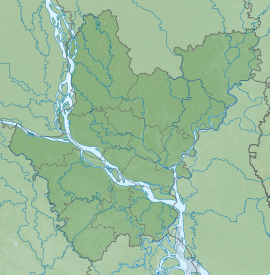সোনারগাঁও | |
|
From top:Goaldi Mosque, Shilpacharya Zainul Folk Arts & Crafts Museum, Panam Nagar, Panam Nagar Architecture, Neel Kuthi | |
| Location | Narayanganj District, Dhaka Division, Bangladesh |
|---|---|
| Coordinates | 23°38′51″N 90°35′52″E / 23.64750°N 90.59778°E |
| History | |
| Founded | Antiquity |
| Abandoned | 19th century |
Sonargaon (Bengali: সোনারগাঁও; Bengali pronunciation: [ˈʃonaɾɡãʋ];[1] lit. Golden Hamlet) is a historic city in central Bangladesh. It corresponds to the Sonargaon Upazila of Narayanganj District in Dhaka Division.
Sonargaon is one of the old capitals of the historic region of Bengal and was an administrative center of eastern Bengal. It was also a river port. Its hinterland was the center of the muslin trade in Bengal, with a large population of weavers and artisans. According to ancient Greek and Roman accounts, an emporium was located in this hinterland, which archaeologists have identified with the Wari-Bateshwar ruins of the Gangaridai Empire. The area was a base for the Vanga, Gangaridai, Samatata, Sena, and Deva dynasties.
Sonargaon gained importance during the Delhi Sultanate. It was the capital of the sultanate ruled by Fakhruddin Mubarak Shah and his son Ikhtiyaruddin Ghazi Shah. It hosted a royal court and mint of the Bengal Sultanate and also the capital of the Bengal Sultanate under the reign of Ghiyasuddin Azam Shah. Sonargaon became one of the most important townships in Bengal. Many immigrants settled in the area. The Sultans built mosques and tombs. It was later the seat of the Baro-Bhuyan confederacy that resisted Mughal expansion under the leadership of Isa Khan and his son Musa Khan. Sonargaon then became a district of Mughal Bengal. During British colonial rule, merchants built many Indo-Saracenic townhouses in the Panam neighborhood. Its importance was eventually eclipsed by the nearby Port of Narayanganj which was set up in 1862.
Sonargaon draws many tourists each year in Bangladesh. It hosts the Bangladesh Folk Arts and Crafts Foundation, as well as various archaeological sites, Sufi shrines, Hindu temples, and historic mosques and tombs.
- ^ Duarte Barbosa; Mansel Longworth Dames (1996) [1918–1921]. The book of Duarte Barbosa : An Account of the Countries Bordering on the Indian Ocean and Their Inhabitants. Asian Educational Services. pp. 138–139. ISBN 81-206-0451-2.






